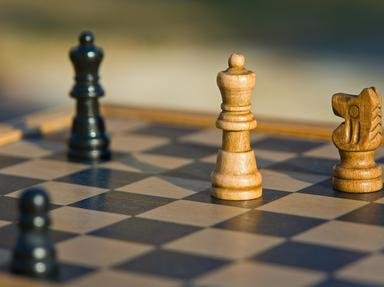Quiz Answer Key and Fun Facts
1. The most basic endgame is king and pawn vs. lone king. The general rule here is that the lone king can draw if he can get his king in front of the advancing pawn, otherwise he loses. However, it is not automatic, he must still play correctly. In the simple position with White king on e5, White pawn on f6, and Black king on f7, which of Black's four possible moves must he play to ensure the draw?
2. Perhaps the most frequently occurring endgame is that of rook and pawn vs. rook. There are two general types of this endgame; one is when the weak side's king blocks the pawn's advance, and the other when the strong side's rook has the weak side's king cut off by a file from the pawn. This latter situation, with the strong side's pawn on the 7th rank, has come to be known as the _________ Position.
3. When the Black king blocks the pawn in the rook and pawn vs. rook endgame, then it is called the Philidor Position. Take the position White king on f5, pawn on f6 and rook on h7; Black king on f8 and rook on a6. Which of the following statements is true about this position?
4. The ending of queen vs. pawn on the 7th rank is frequently seen, usually after one side has won the race to queen a pawn, leaving the other to try to follow suit. Assuming the Black king is protecting his pawn, that the White king is far away from the action, and that both sides play correctly, which of the following statements is correct about this endgame?
5. Assuming best play by both sides, a lone king will always lose against an opponent with a king, bishop, and pawn, regardless of which file the pawn is on.
6. You have only a light-squared bishop and your opponent has only a dark-squared bishop and a pawn on the fifth rank. On which file should your opponent's pawn be in order for you to be able to force3 a draw?
7. You have a king, knight, and pawn, while your opponent has only a king and knight. On which file would you prefer your pawn to be in order to give you maximum winning chances?
8. Consider the position with White's king at a4 and White pawn at d3, and Black with a bare king at a6. With best play, if it is White's turn he only draws, but if it is Black's turn in this position Black will lose. Which endgame principle does this position illustrate?
9. Consider the position with White pawns at a5 and c6 and White king at d5. Black has a pawn on a6 and king on c8. If it were Black to move Black would lose in straightforward fashion. But with White to move it is not so simple. What maneuver must White execute with his king in order to secure the win?
10. Finally, let us consider another king and pawn position. White's pawn is on a6 and his King on f7, while Black's pawn is on a7 and his king on c2. Obviously both Kings want to get to where the pawns are. If it is White to move, what maneuver must he use to ensure the win?
Source: Author
chessart
This quiz was reviewed by FunTrivia editor
ozzz2002 before going online.
Any errors found in FunTrivia content are routinely corrected through our feedback system.
